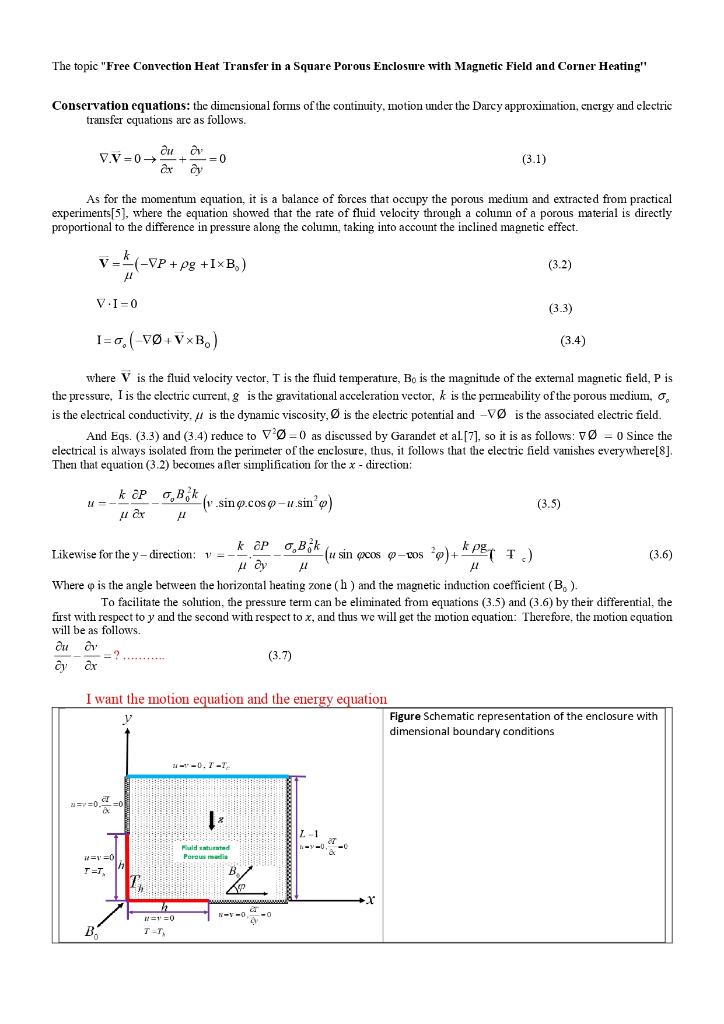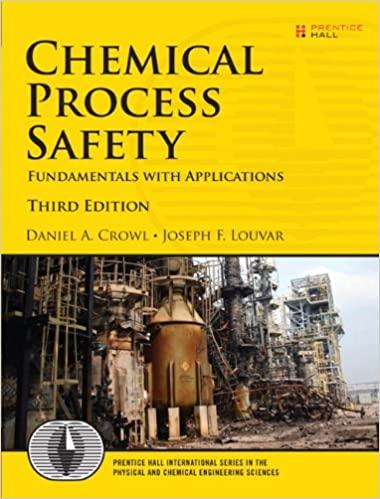
The topic "Free Convection Heat Transfer in a Square Porous Enclosure with Magnetic Field and Corner Heating" Conservation equations: the dimensional forns of the continuity, motion under transfer equations are as follows. Darcy approximation, energy and electric V.V=0 ou ax av CV = 0 (3.1) As for the momentum equation, it is a balance of forces that occupy the porous medium and extracted from practical experiments[5], where the equation showed that the rate of fluid velocity through a column of a porous material is directly proportional to the difference in pressure along the column, taking into account the inclined magnetic effect. v = (-vP + PS + Pg +IXB.) (3.2) VI-0 (3.3) I=0,( V.VB) (3.4) where V is the fluid velocity vector, T is the fluid temperature, Bo is the magnitude of the external magnetic field, P is the pressure, I is the electric curent, g is the gravitational acceleration vector, k is the permeability of the porous medium, o, is the electrical conductivity. It is the dynamic viscosity, is the electric potential and -V is the associated electric field. And Eqs. (3.3) and (3.4) reduce to V 0-0 as discussed by Garandet et al. [7], so it is as follows: 10 = 0 Since the electrical is always isolated from the perimeter of the enclosure, thus, it follows that the electric field vanishes everywhere[8]. Then that equation (3.2) becomes after simplification for the x - direction: k P ,BAK (v.sino.coso-u.sin') (3.5) u ex U- 1 Likewise for the y- direction: v = k aP ,Bik (u sin ooos 0-105 *)+ * pE/ 1) (3.6) u u Where o is the angle between the horizontal heating zone (h ) and the magnetic induction coefficient (B.). To facilitate the solution, the pressure term can be eliminated from equations (3.5) and (3.6) by their differential, the first with respect to y and the second with respect to x, and thus we will get the motion equation: Therefore, the motion equation will be as follows. du dr (3.7) ay ax I want the motion equation and the energy equation Figure Schematic representation of the enclosure with dimensional boundary conditions V =0.2=0 ar 1 2-1 dad Porous media 3D%3D0 TOT 2 B. ==0 T-T The topic "Free Convection Heat Transfer in a Square Porous Enclosure with Magnetic Field and Corner Heating" Conservation equations: the dimensional forns of the continuity, motion under transfer equations are as follows. Darcy approximation, energy and electric V.V=0 ou ax av CV = 0 (3.1) As for the momentum equation, it is a balance of forces that occupy the porous medium and extracted from practical experiments[5], where the equation showed that the rate of fluid velocity through a column of a porous material is directly proportional to the difference in pressure along the column, taking into account the inclined magnetic effect. v = (-vP + PS + Pg +IXB.) (3.2) VI-0 (3.3) I=0,( V.VB) (3.4) where V is the fluid velocity vector, T is the fluid temperature, Bo is the magnitude of the external magnetic field, P is the pressure, I is the electric curent, g is the gravitational acceleration vector, k is the permeability of the porous medium, o, is the electrical conductivity. It is the dynamic viscosity, is the electric potential and -V is the associated electric field. And Eqs. (3.3) and (3.4) reduce to V 0-0 as discussed by Garandet et al. [7], so it is as follows: 10 = 0 Since the electrical is always isolated from the perimeter of the enclosure, thus, it follows that the electric field vanishes everywhere[8]. Then that equation (3.2) becomes after simplification for the x - direction: k P ,BAK (v.sino.coso-u.sin') (3.5) u ex U- 1 Likewise for the y- direction: v = k aP ,Bik (u sin ooos 0-105 *)+ * pE/ 1) (3.6) u u Where o is the angle between the horizontal heating zone (h ) and the magnetic induction coefficient (B.). To facilitate the solution, the pressure term can be eliminated from equations (3.5) and (3.6) by their differential, the first with respect to y and the second with respect to x, and thus we will get the motion equation: Therefore, the motion equation will be as follows. du dr (3.7) ay ax I want the motion equation and the energy equation Figure Schematic representation of the enclosure with dimensional boundary conditions V =0.2=0 ar 1 2-1 dad Porous media 3D%3D0 TOT 2 B. ==0 T-T







